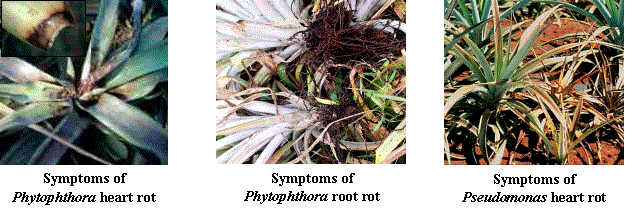|
Plant Protection-Mauritius
Sun burn:
This anomaly occurs usually when the pineapple plant leans or falls over exposing
one side of the fruit directly to the rays of the sun, thus resulting in long exposure
of the peel, and flesh beneath it, to fairly high temperatures.
Affected fruits show a yellowish color in the area exposed to the sun. As the anomaly
progresses the yellow area changes to brown and the flesh beneath it becomes more
translucent. The peel may crack between the fruitlets, the flesh dries out and becomes
spongy. The occurrence of sunburn during early stages of fruit development reduces
the growth rate on the area exposed to the sun thus resulting in an asymmetric fruit.
During summer months protection from the scorching sun can be done by putting dried
grasses, coconut or arecanut leaves.
Diseases
Heart rot/root rot
Disease symptoms:

Heart rot disease of pineapples caused by Phytophthora spp. is characterised
by yellow-red coloured leaves that are easily pulled from the plant and white leaf
bases that bear a distinct water-soaked grey-brown transverse lesion. The lesion
progresses slowly from the base of the leaf to the tip. Rotting pineapple fruit
tissue may also smell badly. If the pineapple plants develop root rot, aboveground
symptoms include stunting and low yield.
Heart rot caused by Psuedomonas spp. is characterized by yellowing, leaf
tip dieback, and tipping of the plant caused by rotting of the growing point.
Pineapple leaf spot occurs frequently in moist and warm climate parts of India.
Initial symptoms are in the form of water soaked lesions on the leaves. The spots
later on enlarge in size and gradually dries up.
Management:
Providing drainage is most essential for the management of heart rot. The
water table should be at least 60 cm below the soil surface. Badly affected
plants should be destroyed and the remaining plants should be drenched with 1% Bordeaux
mixture in the soil. Leaf spot can be controlled by spraying 1% Bordeaux mixture
or 0.2% zineb / mancozeb.
Pests
Mealy bugs (Dysmicoccus brevipes / Pseudococcus
bromeliae)
Mealybugs infest commercial pineapple plantings, affecting pineapple production
in several ways. The rapid spread of this malady in the field is largely due to
the feeding habit of bugs. Symptoms first appear on roots which cease to grow, eventually
leading to collapse of tissues. Feeding of Dysmicoccus species on pineapple
produces a toxic effect called mealybug stripe, expressed as green or black striped
areas. The most predominant symptom is wilting of leaves, commencing from leaf tips.
Reddish-yellow colour develops in the wilting areas. Finally the plants rot and
develop decaying suckers. Fruits developed are undersized. Ants of several species
act as carriers of mealy bugs.
Spray quinalphos 0.05% or chlorpyriphos 0.05% or dimethoate 0.05%. Care should
be taken that the spray shall reach the base and also the sides of the plant.
The plot should be kept weed free. For the control of mealy bugs, control
of ants is a must. Hence apply carbaryl to control ants in its colonies in
the farm.
Scale insects (Diaspus bromeliae)
The spraying of chemicals for the control of mealy bugs, mentioned above, will be
sufficient for the control of scale insects.
Top
|